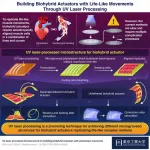(Press-News.org)
Ultraviolet-laser processing is a promising technique for developing intricate microstructures, enabling complex alignment of muscle cells, required for building life-like biohybrid actuators, as shown by Tokyo Tech researchers. Compared to traditional complex methods, this innovative technique enables easy and quick fabrication of microstructures with intricate patterns for achieving different muscle cell arrangements, paving the way for biohybrid actuators capable of complex, flexible movements.
Biomimetic robots, which mimic the movements and biological functions of living organisms, are a fascinating area of research that can not only lead to more efficient robots but also serve as a platform for understanding muscle biology. Among these, biohybrid actuators, made up of soft materials and muscular cells that can replicate the forces of actual muscles, have the potential to achieve life-like movements and functions, including self-healing, high efficiency, and high power-to-weight ratio, which have been difficult for traditional bulky robots that require heavy energy sources. One way to achieve these life-like movements is to arrange muscle cells in biohybrid actuators in an anisotropic manner. This involves aligning them in a specific pattern where they are oriented in different directions, like what is found in living organisms. While previous studies have reported biohybrid actuators with significant movement using this technique, they have mostly focused on anisotropically aligning muscle cells in a straight line, resulting in only simple motions, as opposed to the complex movement of native muscle tissues such as twisting, bending, and shrinking. Real muscle tissues have a complex arrangement of muscle cells, including curved and helical patterns.
Creating such complex arrangements requires the formation of curved microgrooves (MGs) on a substrate, which then serve as the guide for aligning muscle cells in the required patterns. Fabrication of complex MGs has been achieved by methods such as photolithography, wavy micrography and micro-contact printing. However, these methods involve multiple intricate steps and are not suitable for rapid fabrication.
To address this, a team of researchers from Tokyo Institute of Technology (Tokyo Tech) in Japan, led by Associate Professor Toshinori Fujie from the School of Life Science and Technology, has developed an ultraviolet (UV) laser-processing technique for fabricating complex microstructures. “Based on our previous prototypes, we hypothesized that biohybrid actuators using an SBS (hard rubber) thin film with arbitrary anisotropic MGs fabricated by a UV laser processing can control cellular alignment in an arbitrarily anisotropic direction to reproduce more life-like flexible movements,” explains Dr. Fujie. Their study has been published in the journal Biofabrication.
The novel technique includes forming curved MGs on a polyimide through UV-laser processing, which are then transcribed onto a thin film made of SBS. Next, skeletal muscle cells called myotubes, found in living organisms, are aligned using the MGs to achieve an anisotropic curved muscle pattern. The researchers used this method to develop two different biohybrid actuators: one tethered to the glass substrate and the other untethered. Upon electrical stimulation, both actuators deformed through a twisting-like motion. Interestingly, the biohybrid actuator when untethered, transformed into a 3D free-standing structure, due to the curved alignment of myotubes like a native sphincter.
“These results signify that compared to traditional methods, UV-laser con is a quicker and easier method for the fabrication of tunable MG patterns. This method raises intriguing opportunities for achieving more life-like biohybrid actuators through guided alignment of myotubes,” remarks Dr. Fujie, emphasizing the potential of this innovative technique.
Overall, this study demonstrates the potential of UV-laser processing for the fabrication of different anisotropic muscle tissue patterns, paving the way for more life-like biohybrid actuators capable of complex, flexible movements!
Toshinori Fujie Research Group
Aero/Aqua Biomimetics Lab (Hiroto TANAKA Lab)
Revolutionizing Brain Monitoring and Stimulation with Thin-Film Neural Electrodes | Tokyo Tech News
Research video: Fighting cancer with heat! | Tokyo Tech News
Biocompatible thin film: Heating tissue with surgical precision to kill cancer! | Tokyo Tech News
About Tokyo Institute of Technology
Tokyo Tech stands at the forefront of research and higher education as the leading university for science and technology in Japan. Tokyo Tech researchers excel in fields ranging from materials science to biology, computer science, and physics. Founded in 1881, Tokyo Tech hosts over 10,000 undergraduate and graduate students per year, who develop into scientific leaders and some of the most sought-after engineers in industry. Embodying the Japanese philosophy of “monotsukuri,” meaning “technical ingenuity and innovation,” the Tokyo Tech community strives to contribute to society through high-impact research.
https://www.titech.ac.jp/english/
END
[Vienna, Feb 26 2024] — Leptospirosis is a globally distributed infectious disease that affects both animals and humans. While the infection is endemic in tropical regions, its incidence seems to increase in temperate regions. The serological diagnostic test used in routine to detect antibodies against the bacteria responsible for the disease performs better when local variants are used. In Austria, however, no locally circulating strain has been available to date. A new study, published in the latest issue of Scientific Reports, has now been able to close this research gap.
"In our study, ...
Bethesda, MD (Feb. 26, 2024) — The AGA Research Foundation has announced a $1.4 million endowment grant from The Bern Schwartz Family Foundation. The AGA Institute will provide matching support, resulting in a $2.8 million endowment dedicated to advancing basic research in pancreatic cancer, the third leading cause of cancer deaths in the U.S.
The endowment will fund a second AGA-Bern Schwartz Family Fund Research Scholar Award in Pancreatic Cancer. The first award, created in 2013, will also continue. Both awards provide selected early career-investigators with $100,000 per year for three years ...
Calls to U.S. poison centers involving psilocybin, or “magic mushrooms,” among adolescents and young adults rose sharply after several U.S. cities and states began decriminalizing the hallucinogen, University of Virginia School of Medicine researchers have found.
Psilocybin-related calls more than tripled among teens ages 13-19 from 152 to 464 and more than doubled among adults ages 20-25 from 125 to 294 between 2018 and 2022, according to anonymized data gathered from the National Poison Data System. Local and state efforts to decriminalize the possession, use and cultivation of psilocybin began in May 2019. Oregon and Colorado have decriminalized psilocybin, as ...
The average researcher thinks they are better than their colleagues at following good research practice. They also think that their own research field is better than other research fields at following good research practice. This is shown in a new study by researchers at Linköping University, Sweden. The results point to a risk of becoming blind to one’s own shortcomings, according to the Linköping researchers.
“The starting point for the project is that there’s a bit of a crisis in the research world. Research misconduct or difficulties to replicate research results have been discovered in many studies. Credibility has been called into question,” ...
When you get a tattoo, do you know what you’re putting under your skin? According to new Binghamton University research, the ingredient labels on tattoo ink don’t match the actual substances in the bottle.
Produced by the lab of Binghamton Univerity Assistant Professor of Chemistry John Swierk, “What’s in my ink: An analysis of commercial tattoo ink on the U.S. market” was recently published in the journal Analytical Chemistry.
Swierk’s lab explores the potential impact of light on tattoos and their chemical breakdown. Early on, doctoral student Kelli Moseman ...
As we get older, we may start to notice it takes us longer to find the right words. This can lead to concerns about cognitive decline and dementia.
However, a new study by Baycrest and the University of Toronto suggests that talking speed is a more important indicator of brain health than difficulty finding words, which appears to be a normal part of aging. This is one of the first studies to look at both differences in natural speech and brain health among healthy adults.
“Our results indicate that changes in general talking speed may reflect changes in the brain,” says Dr. Jed Meltzer, ...
Deforestation, a critical consequence of human activity, has garnered significant attention due to its impact on environmental sustainability, biodiversity and climate change. However, an equally pressing yet less explored aspect is the relationship between deforestation and human health, especially in impoverished regions. Scientists have increasingly recognized the detrimental effects of deforestation on various aspects of human health, particularly among children. Studies reveal that children residing in areas with high deforestation rates are at an elevated risk of malaria, ...
In 2023, Rhode Island, Massachusetts and Minnesota joined a growing list of states that allow undocumented immigrants to obtain driver’s licenses if an applicant can provide certain documentation, such as a foreign birth certificate or passport and evidence of current residency in the state. Altogether, 19 states and the District of Columbia have similar legislation in place. And lawmakers in other states, such as Michigan and Oklahoma, have introduced similar legislation.
In many cases, these laws were passed ...
In a study in today’s (Monday Feb. 26) Nature Human Behavior, scientists delve into the world of chemical neuromodulators in the human brain, specifically dopamine and serotonin, to reveal their role in social behavior.
The research, conducted in Parkinson's disease patients undergoing brain surgery while awake, homed in on the brain’s substantia nigra, a crucial area associated with motor control and reward processing.
Led by Virginia Tech computational neuroscientist Read Montague, the international team revealed ...
BOSTON – About eight million people live with Type 1 diabetes (T1D) worldwide, a chronic autoimmune condition in which the body attacks and destroys its own insulin-producing β-cells (pronounced “beta”) in the pancreas, leading to a lack of insulin and inability to regulate blood sugar. It’s not known why the body suddenly perceives its own β-cells as the enemy; some lines of evidence suggest environmental factors such as viral infections may trigger the onset of T1D, others suggest genetics may also play some role.
Groundbreaking ...







